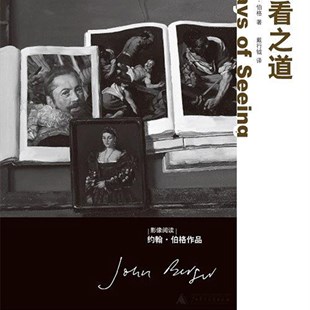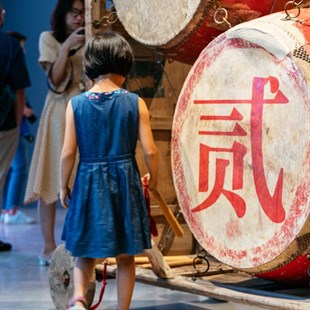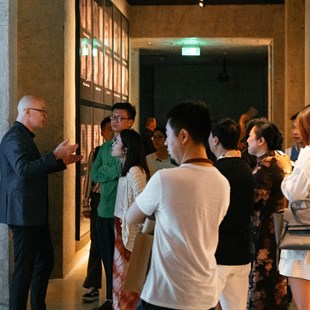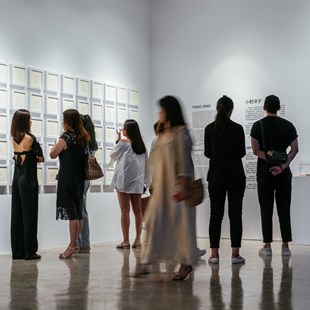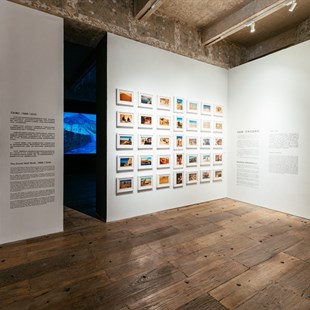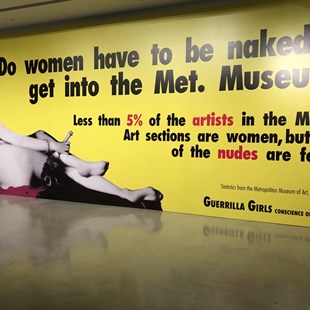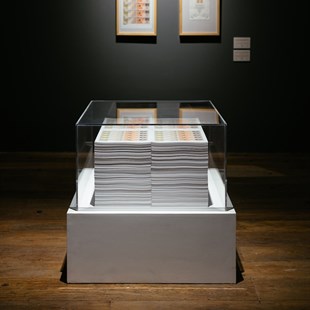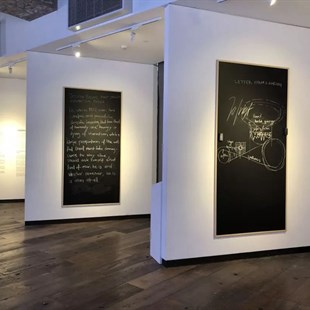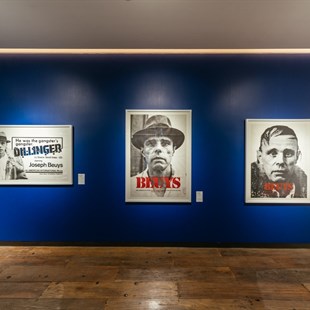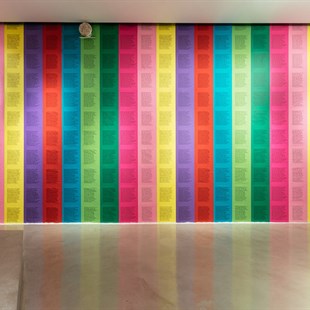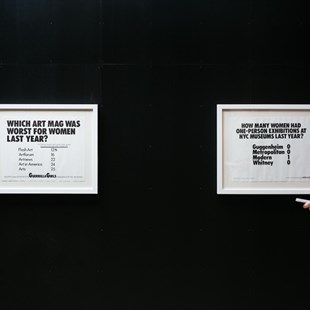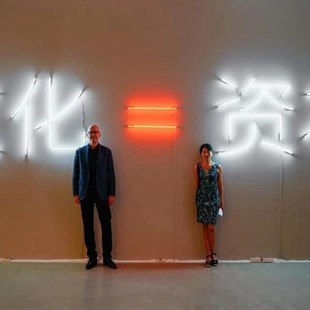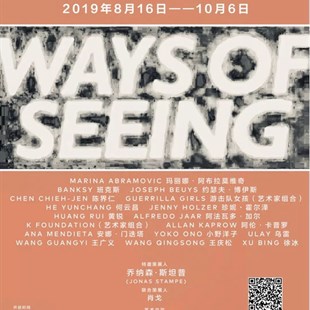
“The relation between what we see and what we know is never settled.” In the 1970s, British author and critic John Berger’s groundbreaking television series “Ways of Seeing” broadcast on the BBC in 1972 and a book was published in the following year. It placed art into the social environment and formed a process to develop a discussion, reexamining the function and meaning of “seeing” in the field of art. The book highlights visual issues such as objects of “seeing”, art and capital, women and art, the challenge of originality and the unique led by photographs and mechanical reproductions. Topics of love, sex, equality, social justice and destruction among others are also discussed in the book, which has influenced western art critics to a great extent.
The exhibition “Ways of Seeing” held by CHAO Art Center is a homage to John Berger curated by art historian Jonas Stampe. By borrowing the title from John Berger’s achievement, this exhibition develops as a profound discussion regarding concepts behind contemporary art as a way of integrating western notions with a Chinese context. It presents artworks from 17 groups of artists in total featuring 65 years of art creations. “Ways of Seeing” seeks to extend the discussion proposed by John Berger in the last century to current situations and it re-proposes the notion of “reading contemporary art”. Meanwhile, by presenting some monuments from the history of contemporary art along with an awareness of art theory and originality powered by historical knowledge, the exhibition intends to redefine the concept of “monumentality” and reconsider the current meaning and future influence of “monumental artworks”.
On the occasion of the closing of the exhibition “Ways of Seeing”, CAFA ART INFO offered a special invitation to curator Jonas Stampe and co-curator Xiao Ge to interpret the story and curatorial methodology behind the exhibition.
Interview conducted by Emily Weimeng Zhou
Interviewees: Jonas Stampe, Xiao Ge
Text by Emily Weimeng Zhou
Edited by Sue/CAFA ART INFO
Photo courtesy of the organizer
CAFA ART INFO: “Ways of Seeing” is well reputed by both scholars and general audiences. We are curious about the origin and background of this exhibition. Can you share the opportunity in terms of facilitating this exhibition with us?
Xiao Ge: The origin of this exhibition could be dated back to 2017. At that time, CHAO Art Space held the exhibition “MAKING—Printmaking and Expanded Media” curated by Fei Jun. In the opening ceremony, introduced by Su Xinping, Vice President of CAFA, who used to be my lithography tutor, Jonas and I met Li Ming, the founder of CHAO Art Center, and his wife, Fei Qi. Li Ming and I are alumni of the Department of Printmaking at CAFA. Li Ming said that exhibitions in CHAO Art Center normally start from the idea of printmaking; however, he would like to expand the understanding of printmaking and open up to diversified interpretations and extensions. CHAO possesses a famous printing machine which contains the traces of many art masters’ works. The encounter with this printing machine became the starting point of this exhibition. Based on this, many discussions were developed between the CHAO team and us. In the proposal at the very beginning, the printing machine was placed in the exhibition hall around other related artworks. However, several conversations with Yang Jun, Art Director of CHAO Art Center, inspired us with more direction and ideas. We realized that the concept should not be restricted to the glory of this printing machine. Instead, based on the awareness of art theory and historical knowledge, this exhibition could represent the “monuments” that then enlighten the current Chinese art circle.
During the preparation process of nearly 18 months and a number of complicated factors, the exhibition schedule was delayed and was even about to be cancelled. However, with the massive support of director Li Ming and the excellent teamwork led by art director Yang Jun, “Ways of Seeing” was eventually realized.
As the exhibition includes many reputable international art masters’ works, during the preparation process, Jonas was in charge of communicating and coordinating with artists and art studios outside China.
CAFA ART INFO: I have learned that the title “Ways of Seeing” is borrowed from John Berger’s groundbreaking television series which then went onto become a book during the last century. How do you interpret this title? What is the inner relationship between John Berger’s “Ways of Seeing” and this exhibition?
Jonas Stampe: My friend John Berger wrote the book “Ways of Seeing” which influenced the whole history of art. I would like to pay homage to him through this exhibition. Specifically, many issues discussed in John Berger’s book that have a significant influence on me. For example, topics such as women as the object of a vision, sexual differences and results from diversified ways of seeing and the discussion regarding printing and advertising functions in artworks, all of which are also included in this exhibition. Moreover, the notion of “reproduction” discussed by John Berger is represented by a series of artworks featuring printmaking and reproduction to form a visual narrative about human conditions in this exhibition. Although there is a variety in content, format, intention and concepts, many works in this exhibition depict the characteristic of “reproduction”. Based on this, a sort of critical visual language is proposed to question the ideas of originality and uniqueness.
John Berger once said that those who regard life as a landscape are futile in art. In his view, art should not only be decorative or a landscape; it should also pose problems. He hopes to facilitate communication among people through artworks. Many discussed issues do not just exist in the past but also at present and in the future. John Berger is a Marxist, and so am I. We all have a different perspective in viewing the world. John Berger and I are against art as decoration; we believe profound ideological contents behind artworks are necessary.
Xiao Ge: Jonas had known John Berger before as John Berger once wrote a review for Jonas’ parents. Jonas has been greatly impressed and influenced by the book “Ways of Seeing” since he began to learn art history. Therefore, we would like to explore related topics through several classical artworks in both Chinese and western art history. In addition, this should be based on the characteristic of CHAO Art Center, we need to consider the exhibition through the perspective of printmaking.
The astonishingly enormous scale should not be the only feature of alleged “monumental” artworks. As the exhibits in this exhibition—advertisements, posters, vinyl records, brochures, cigarette logos or waste, they are daily items and on a small scale but all act as vehicles for “monumental” artworks. They present a relatively modest attitude to broaden the space of the imagination, which contains deep thoughts that inspire history, the current and the future.
CAFA ART INFO: It clarifies that the meaning of a piece of work should not only act on history. Instead, it should expand its influence to the social situations at present and point out the direction of the future.
Xiao Ge: Exactly. When we try to define the notion of contemporary, we may consider an artwork’s “influence” to replace the factor of a “creation date”. That is to say, judging from the importance of artwork should not lie in its creation date but ideologies it delivers at present and in the future. The classical works will never fade. This kind of work clarifies an exoteric perspective regarding time and the contemporary. Jonas observes the field of Chinese contemporary art from the perspective of an outsider, he holds the view that monumental artworks are insufficient in Chinese contemporary art. We hope to inspire people to think and create from another perspective through this exhibition, as John Berger’s “Ways of Seeing” used to influence several western generations’ methods in observing art.
CAFA ART INFO: The 17 groups of contemporary artists are reputable world wide. It is obviously a large-scale group show of contemporary art. How do you decide on the list of artists?
Xiao Ge: We selected artists based on their artworks. We chose from the perspective of art history. In addition, Jonas has a connection with several artists such as Bill Drummond from the K Foundation. We are lucky to know the mysterious Banksy through Bill Drummond. As for the choice of Chinese artists, we considered each artist using specific selection criteria. For example, initially, the distribution of male and female artists are almost equal; however, some artists cannot participate in the exhibition due to various reasons. In this case, the final artist list is a result of reasonable deletion and selection.
CAFA ART INFO: As some participating artists have a renowned reputation in the history of contemporary art, will you be worried that these big names might overshadow the concepts you want to convey through this exhibition?
Xiao Ge: I did have the same feeling you mentioned at the very beginning, and I shared my worry with Jonas. For example, will the artist list give audiences a feeling that it is an exhibition targeting online celebrities to disseminate? However, we soon realized that there is nothing to worry about because our research and consideration regarding this exhibition was in depth and serious. We believe spectators will judge the work fairly after observing this exhibition. Among these so-called classical conceptual artworks, we can see the interrelationship between the delivered concepts and some realities in China. It is not only about artists and artworks but also points to the stories behind works. Besides those big names, we have chosen some less famous artists as well. What matters is their artworks. We hope this exhibition could be a point for people to observe and understand the world in this era of networking and fragmentation. Based on the artists’ originality and broad artistic view, we have to inspire the imagination of “possibility” and “impossibility”, as well as reconsider the nature and the future of art.
CAFA ART INFO: After reading the introduction to this exhibition, my understanding is of a multi-perspective interpretation. The exhibition seems to break the fixed interpretation accepted by the public by presenting these multi-media artworks in the same field to reconstruction as a new narrative space. Thus it intends to encourage multiple dimensional thoughts and understanding.
Xiao Ge: Yes, it can be understood just as you say. Regarding diversified interpretations, I think it is not a bad thing. There are a thousand Hamlets in a thousand people’s eyes. For example, I love TeamLab’s artworks while Jonas does not. He prefers artworks with profound meanings. But it does not matter, because the way to view art should not be homogeneous.
CAFA ART INFO: When we mention the multi-dimensional reading of contemporary art, besides experts and professionals’ explanations, I think viewers with diversified backgrounds can enrich the interpretations of artworks to a great extent. What is your expectation in terms of target audiences?
Xiao Ge: The more diverse audience communities could be reached, the more meaningful the exhibition is. “Ways of Seeing” is an academic exhibition which will definitely attract spectators with related knowledge. Meanwhile, the big names of participating artists, the venue located at commercial center Sanlitun and the interdisciplinary nature of CHAO Art Space featuring no boundary between life and art, will absolutely attract the general public. Diversified audience groups can bring different experiences and understanding, which echoes the notion of questioning and breaking the elite thinking model emphasized by John Berger and artists in this exhibition.
CAFA ART INFO: Apart from topics we mentioned above, “Ways of Seeing” seems to discuss many influential issues within the field of contemporary art, such as the game between art and capital, mass media and art, the challenge of originality and the unique led by photographs and mechanical reproductions among others. When confronting these ambitious and persistent topics, how do you control and balance them during the process of constructing themed ideas and practical installation?
Jonas Stampe: It is not an easy task to deal with such a number of topics, artworks and artists within one exhibition. Different people might have various strategies, some by thought while others by actions. I think the operation between my wife Xiao Ge and I is through love and humanity. I believe in the equality of human nature which is emphasized by John Berger.
CAFA ART INFO: Let’s go back to the exhibition venue itself. CHAO Art Center has always advocated the concept of “unbounded art space”. Based on this, what are the differences for you to curate an exhibition between here and traditional galleries and art museums?
Jonas Stampe: Spectators who go to art museums and galleries are basically art lovers, which means the target audiences of traditional art institutions are fixed. But in this case, it is in the center of Beijing, a commercial center and a hotel can be different. In such a space, people gather here from all over the world with different intentions. They enrich the openness and diversification of this space. In addition, the spaces of art museums and galleries are normally white cubes, while CHAO Art Center is atypia. In this case, new possibilities and vitality can be triggered. Sanlitun is said to be the birthplace of the early pioneers, underground and fashion culture. It is consistent with the tonality of this exhibition. The works with “monumentality” today were actually initiated from the underground environment.
CAFA ART INFO: The exhibition is about to end in a few days. How do you feel about it? Has it reached your expectation?
Jonas Stampe: I hope this exhibition can bring new thoughts and inspiration to audiences. I expect it could not only make an impression in their mind but also touch them from deep in their heart. In this generation, I have viewed a number of beautiful and decorative art, but I insist that art should bear social responsibility and enlighten the public. I never comment “good art” or “bad art”; I only phrase it as “insightful art” or “superficial art” instead.


